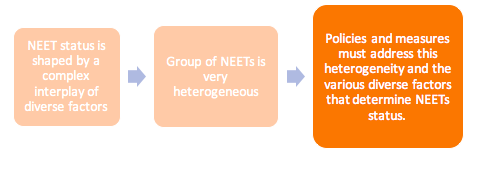Looking at the situation and background of NEETs over 25 and addressing the various factors and vulnerabilities they face; it became clear that NEETs over 25 in particular often have lower incomes and a higher risk of poverty than their counterparts. Many faces financial problems, including significant debt, especially in the 25-29 age group. In addition, NEET rates tend to be significantly higher in rural areas where access to education, job opportunities, and infrastructure is limited. The prevalence of school dropouts in rural areas contributes to these high NEET rates. Health problems, both mental and physical, are common reasons for NEET status in this age group. NEETs are more likely to have mental health problems and often face long-term health problems that prolong their NEET status. Furthermore, gender differences are evident, with women more likely to be NEETs than men. Caregiving responsibilities, gender discrimination in education and employment, and adherence to traditional gender roles contribute to these differences.
Building upon this, it is important to understand that the group of NEETs over 25 is very heterogeneous. There can be different reasons why a person is a NEET and these reasons, in turn, can shed light on why NEETs remain in this status for a longer period of time. Some NEETs have (chronic) health problems, others are young mothers, and still others have low formal education and/or live in areas/countries with a difficult labour market situation. The mentioned reasons for NEET status should not be considered in isolation, i.e. there are often multiple reasons why 25–29-year-old young people become NEETs or remain in this status temporarily or long-term: due to their heterogeneity, 25+ NEETs have very different needs and face different challenges.
Moreover, there are country-specific and systemic factors that influence the risk of becoming and remaining NEET. For example, lower NEET rates at age 25 and older may generally be associated with higher levels of GDP. Income inequality tends to correlate with higher NEET rates, as is the case in Romania, Bulgaria, Greece, and Spain, all countries with high NEET rates. Particularly between 2018 and 2020, these countries specifically have experienced an increase in income inequality. In general, countries with higher income inequality also have a higher proportion of people at risk of poverty or social exclusion. Spain and Greece generally have one of the highest unemployment rates. In Spain in particular, the labour market has deteriorated rapidly due to crises such as the financial crisis and the COVID-19 pandemic – which has also led to an increase in the number of NEETs. The impact of these crises has varied from country to country; countries with low 25+ NEET rates, such as Malta, were only moderately and temporarily affected by the pandemic. However, as these crises created uncertainty in most countries, especially in the labour market, it is particularly important to use the experience gained in recent years to reduce NEET rates among those over 25 in general, but also to take measures to prevent the number from rising again in the event of a future crisis.
Therefore, the NEET status for young people over 25 is shaped by a complex interplay of factors, encompassing socio-economic conditions, urbanization, health, ethnicity, gender, and discrimination. A comprehensive understanding of these challenges is essential for the development of effective policies and interventions aimed at supporting and reintegrating NEETs into education and employment.

[1] This article was prepared based on the Transnational research report on the situation of 25+ NEETs in the EU and in beneficiary countries, developed in the framework of the Lost Millennials project.
by Stella Wolter
Centre for Social Innovation
Lost Millennials project


